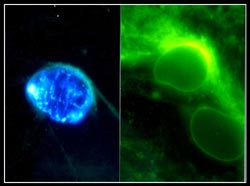
NIAB has patent protection pending for a number of schemes for encoding non-genetic information into DNA. The patent describes four methods by which DNA can be made to hold information in a binary or other number base format as a DNA ’barcode’.
Jonathan White, Head of NIAB’s Molecular and Genotyping Group said, “The encoding of non-genetic information has the overall major benefit of providing a means of ready identification and authentication of goods and organisms and is particul

Educators and scientists should discard the idea that a cell’s nucleus is just a bag of chromosomes, according to Johns Hopkins’ cell biologist Kathy Wilson, Ph.D. In a Feb. 17 session at the annual meeting of the American Association for the Advancement of Science (AAAS) in Denver, Wilson and five others will introduce visual evidence of the nucleus’s newly recognized importance.
“The old view is that the nucleus is simply a warehouse for chromosomes,” says Wilson, associate

New molecular technologies, some driven by the work of a researcher at the University of Illinois at Urbana-Champaign, are exposing unexpectedly high levels of DNA folding and complex protein-rich assemblages within the nucleus of cells that he says “seriously challenge the textbook models.”
“What we are seeing suggests that there may be machinery, not yet identified, that controls the folding and the movements of enzymes that turn genes on and off,” said Andrew Belmont, a professor of cell

The U.S. Government is spending millions of dollars to research the feasibility of stuffing carbon dioxide into coal seams and fields of briny water deep beneath the Earth. But, a scientist at the American Association for the Advancement of Science (AAAS) Annual Meeting argues that the government isn’t thinking big enough in its plans to remove carbon dioxide from the atmosphere.
Dissatisfied with the long-term potential of most current technologies for carbon sequestration, Klaus Lack

Researchers from Imperial College London, University of Oxford, Kagoshima University (Japan) and University of the Ryukyus (Japan) have discovered the mechanism by which human T-lymphotropic virus type 1 (HTLV-1), the virus which causes adult T-cell leukaemia, spreads through the body.
Previously it was not understood how HTLV-1 was able to spread between cells and pass between individuals, but according to research published today in Science, the virus spreads by subverting normal T-cell (a

A research letter in this week’s issue of THE LANCET suggests that the pain-killer ibuprofen could diminish the well-known beneficial effects of aspirin on preventing cardiovascular disease. Aspirin makes platelets (blood-clotting cells) less ’sticky’ which is associated with fewer thromboses (clots). Aspirin therefore reduces the chance of heart attacks caused by coronary thrombosis and stroke (cerebral thrombosis). Previous laboratory research has suggested that ibuprofen in

– new calculation confirms standard model of particle physics. Contribution of hadronic vacuum polarization determined with unprecedented accuracy. The magnetic moment of the muon is an important precision parameter for…
Technique may prevent formation of unwanted waves that siphon off needed energy. Heating plasma to the ultra-high temperatures needed for fusion reactions requires more than turning the dial on a…

An international team of astronomers, led by researchers from the Astronomical Observatory of the University of Warsaw, have identified a new class of cosmic X-ray sources. The findings have been…

Antibody that Neutralizes Inhibitory Factors Involved in Nerve Regeneration Leads to Enhanced Motor Function after Acute Spinal Cord Injury. Researchers at 13 clinics in Germany, Switzerland, the Czech Republic and…

How the body’s natural killer cells could fight leukemia. Every year, some 13,000 people in Germany are diagnosed with leukemia. Despite intensive chemotherapy, around one in two of them die….

… eco-friendly reactor converts air and water into ammonia. Producing enough ammonia to feed the world comes with a large carbon footprint;. process described in new UB-led study could help…

How simulations help manufacturing of modern displays. Modern materials must be recyclable and sustainable. Consumer electronics is no exception, with organic light-emitting diodes (OLEDs) taking over modern televisions and portable…

“Neurons that fire together, wire together” describes the neural plasticity seen in human brains, but neurons grown in a dish don’t seem to follow these rules. Neurons that are cultured…

The quest for sustainable energy solutions has been a major focus of scientific research for decades. Solar energy, a clean and renewable source, has emerged as a promising alternative to…

With a processing speed a billion times faster than nature, chip-based laser neuron could help advance AI tasks such as pattern recognition and sequence prediction. Researchers have developed a laser-based…

New technology could remotely identify various types of plastics, offering a valuable tool for future monitoring and analysis of oceanic plastic pollution. Researchers have developed a new hyperspectral Raman imaging…

Artificial Intelligence (AI) has established a strong presence across industries, large and small. The “VoBaKI” research project has empowered small and medium-sized enterprises (SMEs) with an innovative tool to independently…